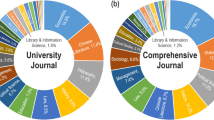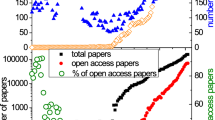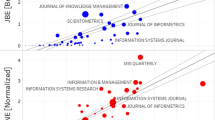Abstract
This article aimed to report Journal Impact Factor (J-IF) and Journal Immediacy Index (J-II) of 68 Thai academic journals during the past five years (from 1996 to 2000) using the calculation method given by the Institute for Scientific Information (ISI). This was the first time that the citation indexes of Thai academic journals were established. With respect to the journal impact factor, the results showed that only six journals have been cited continuously during the past five years, this being 8.8% of the total journal number selected in this work. It was also noticeable that articles published in longer journal age tended to have greater opportunity to be cited and higher journal impact factor. The average impact factor of the 68 journals was relatively low, this being of 0.069, suggesting that the possibility of an article published in a national journal to be cited was only 6.9%. In terms of the immediacy index, it was found that the average immediacy index value was 0.063, which was again very low. No significant relationship between the journal age and the immediacy index could be observed. 47% of the journals have never been able to produce the immediacy index in the past five years, suggesting that articles in the Thai academic journals were hardly cited within the same years they were published.
Similar content being viewed by others
References
The Institute for Scientific Information: ISI, (1999) Philadelphia (USA) in http://www.isinet.com
Stegmann, J., Building a list of journals with constructed impact factors, Journal of Documentation, 55 (1999) 310–324.
Green, A., Deep impact, Advanced Materials, 12 (2000) 1313.
Amin, M., Mabe, M., Impact Factors: Use and abuse, Perspectives in Publishing, (1) (2000) 1–6.
Moed, H. F., van Leeuwen, T. N., Improving the accuracy of Institute for Scientific Information's journal impact factor, Journal of the American Society for Information Science, 46 (1995) 461–467.
Neuberger, J., Counsell, C., Impact factors: Uses and abuses, European Journal of Gastroenterology & Hepatology, 14 (2002) 209–211.
Dumontier, C., Nizard, R., Sautet, A., Impact factors or do we have to choose between the impact factor and the Revue de Chirurgie Orthopedique? Revue de Chirurgie Orthopedique et Reparatrice de l'Appareil Moteur, 87 (2001) 115–128.
Suwannarat, C., Journal Citation Analysis of Foreign Language Research Articles Written by Members of the Faculty of Science, Mahidol University, Master Thesis, Chulalongkorn University, Thailand (1987) [In Thai]
Thongsrisuksai, S., Citation Analysis of Research Papers of Lecturers in Khon Kaen University, KKU Academic Resources Center, Khon Kean Thailand (1996).
Tankeyura, K., Citation Analysis of Master's Theses and Faculty's Research Reports, Faculty of Engineering, King Mongkut's Institute of Technology Ladkrabang. Master Thesis. Chulalongkorn University, Thailand (1986) [In Thai]
Gehanno, J. F., Thirion, B., How to select publications on occupational health: The usefulness of Medline and the impact factor, Occupational and Environmental Medicine, 57 (2000) 706–709.
Johnson, W., Environmental impact: A preliminary citation analysis of local faculty in a new academic program in environmental and health applied to collection development at Texas Tech University Library, Library & Information Science Research, 9 (1999) 1. Available at: http://www.libres.curtin.edu.au/libre9n1/toxcite.htm
Christie, A., Kristick, L., Developing an Online Science Journal Collection: A Quick Tool for Assigning Priorities, Oregon State University, 2001. Available at: http://www.library.ucsb.edu/istl/01-spring/article2.html
Westney, L. H., Historical rankings of science and technology: A citationist perspective, The Journal of the Association for History and Computing, 1 (1998). Available at: http://www.mcel.pacificu.edu/history/jahcI1/Westney/Westney.htm
Lok, C. K., Chan, M.T., Martinson, I. M., Risk factors for citation errors in peer-reviewed nursing journals, Journal of Advanced Nursing, 34 (2001) 223–229.
Author information
Authors and Affiliations
Rights and permissions
About this article
Cite this article
Sombatsompop, N., Ratchatahirun, P., Surathanasakul, V. et al. A citation report for Thai academic journals published during 1996-2000. Scientometrics 55, 445–462 (2002). https://doi.org/10.1023/A:1020423031578
Issue Date:
DOI: https://doi.org/10.1023/A:1020423031578




